First Flight:
Bob Bready
![]()
First Flight:
|
|
by Alfred Scott
This article appeared in the September 1994 issue of the Falco Builders Letter.
There's one happy Falco owner flying around the New England skies these days. Bob Bready flew his Falco for the first time on July 21, 1994, and he's been burning up the air over Westfield, Massachucetts, ever since.
Bob started the Falco in 1982, so his 12-year build time is close to Larry Black's. Like Larry, Bob made most of the parts in the plane and purchased kits for cowling, canopy, seats and some other things. When he started the Falco, Bob had two daughters in college which gave him plenty of time but no money.
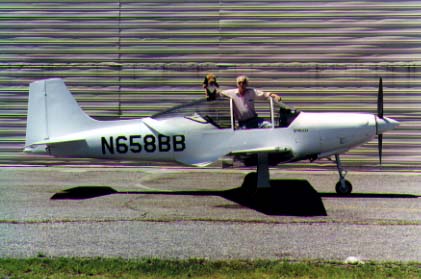
Some builders finish their airplanes and then lose interest after flying for a while, but it's been obvious from the beginning that this will never be the case with Bob. He's owned a long string of airplanes, beginning with a Luscombe T8F Observer, a tandem-seat taildragger with a bubble canopy in the back. This was followed by a Skylane, Aztec, Geronino Apache, a push-pull Cessna twin ("Suck and Blow") and a Baron.
Bob has over 3,500 hours and has spent a lot of time flying Jim DeAngelo's Falco. I asked him how he liked his Falco and how it compared to other Falcos he has flown. "It flies better than it looks!" he said, using Karl Hansen's famous line. His Falco feels the same as the others he's flown. "You're not flying. You're just thinking about it. It's an extension of your fingers."
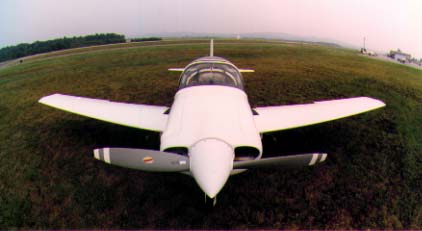
Compared to the other airplanes he's owned, the Falco is "probably the easiest to fly and probably the most fun to fly. It has the best visibility, the best handling, and will be economical enough to put a lot of time on it."
Bob's Falco has a 180 hp engine, weighs 1,303 empty, and so far it has proved to have almost identical performance to Jonas Dovydenas's Falco, although Bob has yet to install the nose gear door, wheel well doors or control hinge fairings-he's looking forward to eating Jonas' lunch once those are installed. Down low, he gets 155-160 knots indicated at 23"/2300, while at 9,500' a typical cruise setting of 21.5"/2400 gets 180 knots groundspeed on the GPS.
Bob is the first to install a King GPS with the moving map display. He had a KLN88 loran, but it worked for 5 minutes and then blew up. Bob swapped it for a KLN90A GPS, essentially the same unit but GPS instead of loran.
The moving map display is something to see operate on a cross-country flight. You can watch as VORs and airports slide by. There are a dozen or so 'pages' in the display, and you can look at your entire flight plan from a zoomed-way-out view, or watch the runway of the airport you're approaching come into view when you enter the pattern. "The Northstar is so easy to use it's not funny, but with this thing you're into computer systems. The joke around here is that if I wreck the Falco, they're going to find the GPS embedded in my face. When you're learning it, you have to sit and think with each step, but it's the cat's meow."
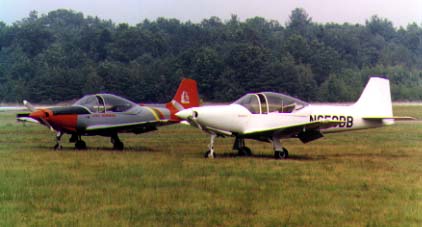
Easily qualified to do so, Bob did his own first flight. Unfortunately, when he did his high-speed taxi tests, he was assigned the cross-wind runway. "There was an 18-knot cross wind, and I looked like a drunken Bob Hoover weaving down the runway."
On his first flight, the engine oil temperatures ran up much higher than they should have, so he retracted the landing gear to get more air flowing over the engine. The problem turned out to be a sticking thermal valve in the oil cooler circuit, which he has since replaced. He put the Falco through the usual feel-it-out process, encountered no other problems and came back and landed. It was fine.
"On the first flight, I was more tuned into how I was going to fly the airplane rather than any emotional thing. The emotional thing, it's just not there. It was a great flight in a different airplane where everything went fine. It was just a mechanic and me. My plans were not to raise the gear, but it was the easiest way to get air over the engine. I put a fire extinguisher in the right seat, mainly so I could use it to break the canopy if I had to get out. It wasn't a chest-beating, whoopee kind of thing, and I think looking to the first flight for an 'experience' is the wrong way to approach it."
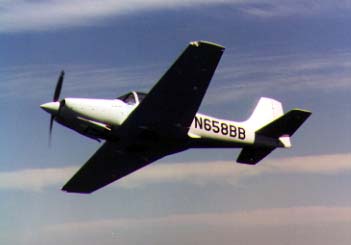
Since then, Bob has been burning up the skies. He now has 65 hours on the Falco. "When I was flying off the first 25 hours, I put 16 hours on it in three days. That put a new meaning to being a pain in the ass."
I asked Bob to compare his 180 hp engine with the 160 hp Falcos he's flown. "There really isn't that much difference in the speed. Where you're seeing it is in the climb-out and acrobatics where the extra 20 horses make a difference."
"I have the inverted fuel system but not an inverted oil system. I'm not into hard acrobatics. I like to make long sweeping 'Mustang maneuvers'. It's what you want to do. I like the airplane because of the way it flies. The first time I did a loop, I stalled it and it got into an inverted spin. It's a bit scary, but you let go of it, chop the power and it grins at you and flies itself out of it."
The stall warning is quite good. "You'd have to be dumber than a rock to not know that the airplane is going to stall. It really rocks and rolls."
I asked Bob if the larger engine contributed to any nose-heaviness. He said it did not. He has a light-weight starter and alternator and this means his 180 hp engine is probably a little lighter than a factory-stock 160 hp engine-so in terms of balance, it is invisible.
On the controls, Bob says that Jonas's are a little smoother, but his are breaking in. The autopilot adds some friction to the system, and you can tell if it is connected or not. He has flutter-tested the Falco at 240 mph, and then took it up to 265 mph but didn't test for flutter at that speed. He says it has a 'Mustang buzz' to it at high speeds, which he thinks may be something in the engine baffling.
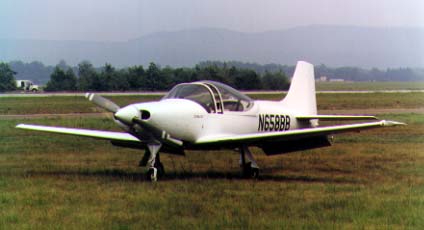
The Falco is currently painted in white, but Bob plans to put some decoration on it. It'll have black on top of the cowling and some stars-and-bars for an airforce trainer scheme.
"People always ask me what it is like. I equate it to having a third child. You're happy it's born, but you don't know what it is going to be like. Every day new and wonderous things take place. I'm in a hangar with eight other airplanes, and I'm the only one here who built his own plane. What a learning experience to put one of these up into the air! About 25% of my life has been with the Falco, and it's been a very large part of my life. It's kept me away from bad women and bar rooms too long." Knowing Bob, I couldn't resist asking him to compare the Falco to women. "You can catch a disease from it, and that disease is not curable with a shot of penicillin either!"
Bob asked me to say that he appreciated all of the support from all of the builders and from us here at Sequoia, for our help and for keeping the design good and clean.
And his advice to other builders working on their Falcos? "Don't build an airplane. Build a piece at a time. And don't be discouraged about how long it takes to build because the end product is worth it. It's like that baby."
Congratulations to our new proud papa.